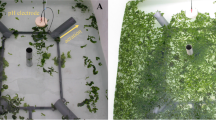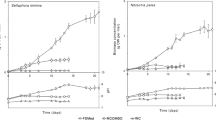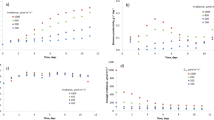Abstract
It is often assumed that the use of a two-stage chemostat yields algal food with a well-defined nutritional composition that can maintain herbivores in a steady state of growth. In this study I investigated two bacteriafree culture techniques, continuous flow chemostats and batch cultures, to determine whether the biochemical composition of the rotifer Encentrum linnhei differed in the two cultures. Changes in the biochemical composition and calorific content of the algal food were also examined. In the rotifer reaction vessel only the lipid content of the algal food increased significantly with dilution rates, while significant decreases in protein and carbohydrates were detected at increasing algal densities. A different pattern was observed in the response of the unused algal cells to variables such as dilution, algal input and algal densities in the sump of the rotifer chemostat. In the chemostat the biochemical composition of the rotifers varied as expected with dilution rates, algal input and food availability but significant differences were found in the biochemical composition of the animals growing in the reaction vessel and those collected from the sump. In contrast, the biochemical content of batch-grown E. linnhei varied with time in a way that depended upon food availability and also on the biochemical state of the algal food. However, at the end of the exponential phase of growth, when maximum densities had been achieved, batch-grown rotifers were more biochemically nutritious than chemostat-grown animals in their steady-state phase.
Similar content being viewed by others
References
Arndt H, Güde H, Macek M, Rothhaupt KO (1992) Chemostats used to model the microbial food web: evidence for the feedback effect of herbivorous metazoans. Arch Hydrobiol Beih Ergebn Limnol 37 (in press)
Ben-Amotz A, Tornabene TG (1985) Chemical profile of selected species of microalgae with emphasis on lipids. J Phycol 21: 72–81
Ben-Amotz A, Fishler R, Schneller A (1987) Chemical composition of dietary species of marine unicellular algae and rotifers with emphasis on fatty acids. Mar Biol 95: 31–36
Bennet WN, Boraas ME (1989) Comparison of population between show-and fast-growing strains of the rotifer Brachionus calyciflorus Pallas in continuous culture. Oecologia 81: 494–500
Boraas ME (1980) A chemostat system for the study of rotifer-algal interactions. In: Kerfoot WC (ed) The evolution and ecology of zooplankton communities. University Press of New England, Hannover, NH, pp 173–182
Boraas ME (1983) Population dynamics of food-limited rotifers in two-stage chemostat culture. Limnol Oceanogr 28: 546–563
Boraas ME, Bennet WN (1988) Steady-state rotifer growth in a two-stage, computer controlled turbidostat. J Plankton Res 10: 1023–1038
Curds CR (1971) A computer-simulation study of predatory-prey relationships in a single-stage continuous-culture system. Water Res 5: 793–812
Curds CR, Bazin MJ (1977) Protozoan predation in batch and continuous culture. In: Droop MR, Jannasch HW (eds) Advances in aquatic microbiology (Vol 1). Academic Press, London, pp 115–171
Curds CR, Cockburn A (1971) Continuous monoxenic culture of Tetrahymena pyriformis. J Gen Microbiol 66: 95–108
Droop MR (1968) Vitamin B12 and marine ecology. IV The kinetics of uptake, growth and inhibition in Monochrysis lutheri. J Mar Biol Ass UK 48: 689–733
Droop MR (1976) The chemostat in mariculture. Proceedings 10th Europ Symp Marine Biology 1975, Ostend, Volume 1, pp 71–93
Droop MR, Scott JM (1978) Steady-state energetics of a planktonic herbivore. J Mar Biol Ass UK 58: 749–772
Droop MR, Scott JM (1982) A steady-state approach to some microplankton problems. Ann Inst Oceanogr Paris 58: 47–54
Fredrickson AG (1977) Behaviour of mixed cultures of microorganisms. Ann Rev Microbiol 31: 63–87
Guisande C, Serrano L, (1989) Analysis of protein, carbohydrate and lipid in rotifers Hydrobiologia 186/187: 339–346
Herbert D, Phipps PJ, Strange RE (1971) Chemical analysis of microbial cells. In: Norris JR, Ribbons DW (eds) Methods is Microbiology. Academic Press, London, pp 210–336
Jannasch HW (1974) Steady state and the chemostat in ecology. Limnol Oceanogr, 19: 716–720
Lowry OH, Rosebrough NJ, Farr AL, Randall RJ (1951) Protein measurement with the folin phenol reagent. J Biol Chem 193: 264–275
Monod J (1950) La technique de culture continue: théorie et applications. Ann Inst Pasteur 79: 390–401
Moss R, Watson A, Ollason J (1982) Animal population dynamics. Chapman and Hall, London, New York
Novick A, Szilard L (1950) Description of the chemostat. Science 112: 715–716
Rothhaupt KO (1985) A model approach to the population dynamics of the rotifer Brachionus rubens in two stage chemostat culture. Oecologia 65: 252–259
Rothhaupt KO (1992) Critical considerations of chemostat experiments. In: Walz N (ed) Plankton regulation dynamics. Experiments and models in rotifer continuous cultures. Springer-Verlag (in press)
Schlüter M, Soeder CJ, Groeneweg J (1987) Growth and food conversion of Brachionus rubens in continuous culture. J Plankton Res 9: 761–783
Schmid-Araya JM (1989) Comparison of the characteristics of two rotifer species, Brachionus plicatilis (O.F. Müller) and Encentrum linnhei Scott, as food organisms and their effect on growth and survival of newly-hatched larvae of the turbot Scophthalmus maximus. Ph.D. Thesis, Royal Holloway and Bedford New College, University of London
Schmid-Araya JM (1991) The effect of food concentration on the life histories of Brachionus plicatilis (O.F.M.) and Encentrum linnhei Scott. Arch Hydrobiol 121: 87–102
Scott JM (1980) Effect of growth rate of the food alga on the growth/ingestion efficiency of a marine herbivore. J Mar Biol Ass UK 60: 681–702
Scott JM (1988) Effect of growth rate on the physiological rates of a chemostat-grown rotifer Encentrum linnhei. J Mar Biol Ass UK 68: 165–177
Scott JM, Marlow JA (1982) A microcalorimeter with ranges of 0.1–1.0 calories. Limnol Oceanogr 27: 585–590
Sokal RR, Rohlf FJ (1981) Biometry. The principles and procedures of statistics in biological research. W.H. Freeman, New York
Spoehr HA, Milner HW (1949) The chemical composition of Chlorella. Effect of environmental consitions. Plant Physiol 24: 120–149
Steele RGD, Torrie JH (1980) Principles and Procedures of Statistics. A Biometrical Approach. McGraw-Hill
Trevelyan WE, Harrison JS (1952) Studies on yeast metabolism. I. Fractionation and microdetermination of cell carbohydrates. Biochem J 50: 298–303
Walz N (1983) Continuous culture of the pelagic rotifers Keratella cochlearis and Brachionus angularis. Arch Hydrobiol 98: 70–92
Zamer WE, Shick MJ (1989) Physiological energetics of the intertidal sea anemone Anthopleura elegantissima. III. Biochemical composition of body tissues, substrate specific absorption and carbon and nitrogen budgets. Oecologia 79: 17–127
Author information
Authors and Affiliations
Rights and permissions
About this article
Cite this article
Schmid-Araya, J.M. The biochemical composition and calorific content of a rotifer and its algal food: comparison of a two stage chemostat and batch culture. Oecologia 92, 327–338 (1992). https://doi.org/10.1007/BF00317458
Received:
Accepted:
Issue Date:
DOI: https://doi.org/10.1007/BF00317458




